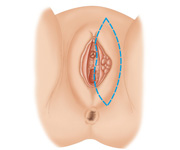 |
Symptoms Of Vulva CancerContents • What Are The Signs Of Vulva Cancer? |
Return To Main Article: |
What Are The Signs Of Vulva Cancer?
The sooner cancer of the vulva is diagnosed, the faster it can be treated and the better the patient's prognosis (see vulva cancer survival rates). The early stage of the disease is called vulvar intraepithelial neoplasia (VIN), also known as carcinoma in situ (and formerly Bowen's disease). VIN is generally considered the pre-cancer stage to vulva cancer, much like VAIN is to vaginal cancer and CIN is to cervical cancer. VIN can cause a burning and itching sensation in the vulva tissue which may be mistaken for less serious problems like vaginitis or yeast infections. In fact many women with the condition initially self-medicate with yeast infections treatments and only seek medical advice when symptoms do not clear. VIN is usually easily detected during a pelvic examination by the presence of white patches of raised skin. A biopsy will need to be carried out to confirm a clinical diagnosis. Fortunately, even if some women miss the early signs of vulvar cancer the prognosis is usually good. Vulvar cancers develop very slowly and do not spread to other parts of the body until the disease is quite advanced (see vulva cancer staging). About 20 percent of patients do not experience symptoms before being receiving a vulva cancer diagnosis. As there are a few different types of vulva cancer, the symptoms can vary slightly. The following is a list of the most common signs according to type of cancer present: Squamous Cell Carcinoma The vast majority of vulvar cancers are squamous cell carcinomas. If they are found in the early stages they are highly curable. Signs include the discovery of one or all of the following:
Other possible signs include: Adenocarcinoma Adenocarcinoma accounts for about 8 percent of all vulvar cancers. Sometimes adenocarcinoma develops in the Bartholin glands which are located near the entrance of the vulva. This can result in a thickened mass on either side of the opening of the vagina. This may be mistaken for a vaginal cyst. Adenocarcinoma which develops in the sweat glands of the vulva skin is called Paget disease. This can cause red scaly skin which burns and itches. Vulva Melanoma The appearance of a new darkened area of skin or lump is a classic sign of this disease – or a change in an already pre-existing mole. One significant study of women with vulva melanoma reported that 15 percent of patients had a family history of melanoma (skin cancer) and that the primary location of melanoma was the clitoris followed by the labia. Researchers reported the following frequency of symptoms in patients:Pruritus (itching): 23 percent. Mass, swelling or lump: 23 percent. Bleeding: 17 percent. Lesion found in routine examination: 15 percent. Lesion found by the patient themselves: 15 percent. Sore that would not heal: 3 percent. Alternation in urination stream: 3 percent. Basal Cell Carcinoma This is an extremely rare form of vulva cancer. A typical sign is a patch of painless red lumps or ulcerations. Comparison of Gynecologic Cancer Symptoms All women should pay attention to their body so they will be able to spot changes if they occur. For example, carrying out a vulva self examination (VSE) on a regular basis will help you become familiar with your reproductive area. To find out how to do a VSE, see our article: Vulva Cancer Prevention. The following is a useful guide to the different symptoms for each gynecologic cancer.
|
| Related Articles on Vulvar Cancers
For more information, see the following: • Thermography Screening Back to Homepage: Womens Health Advice |
|
WOMENS HEALTH ADVICE: ABOUT VULVAR CANCERS |